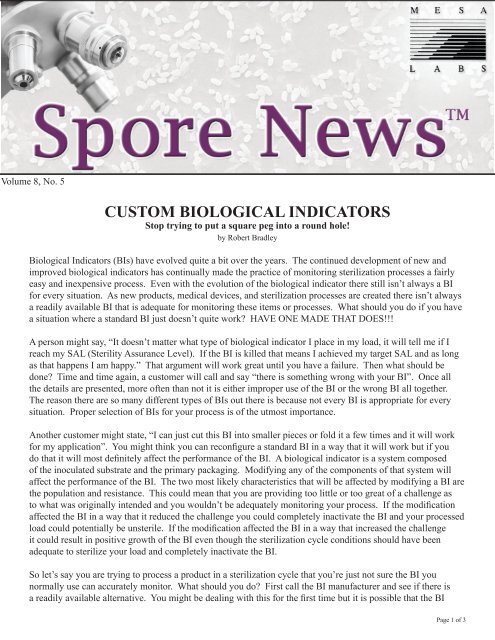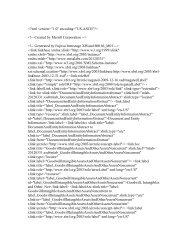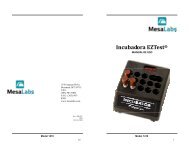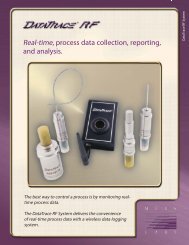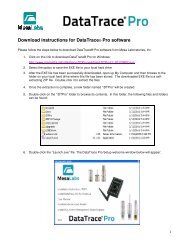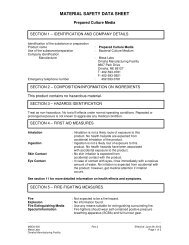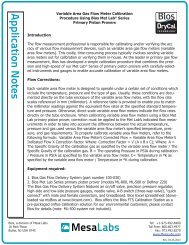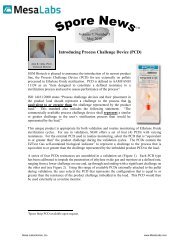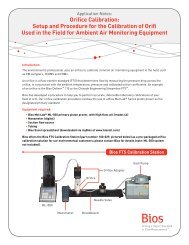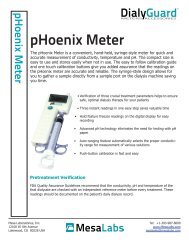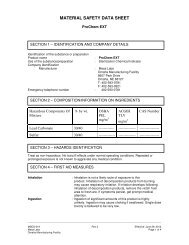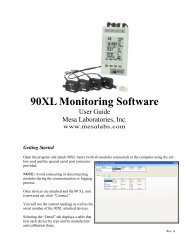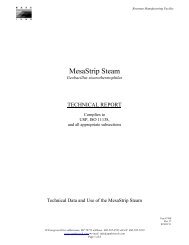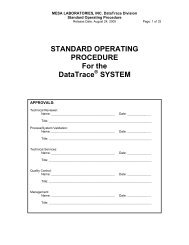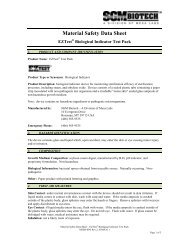CUSTOM BIOLOGICAL INDICATORS - Mesa Labs
CUSTOM BIOLOGICAL INDICATORS - Mesa Labs
CUSTOM BIOLOGICAL INDICATORS - Mesa Labs
You also want an ePaper? Increase the reach of your titles
YUMPU automatically turns print PDFs into web optimized ePapers that Google loves.
manufacturer has dealt with this before and can provide you with an instant solution. If there isn’t an availableBI, the ideal scenario would be to use a custom BI that is specifically tailored to that application.Many BI manufacturers offer specialized BIs for industrial use. Many of these industrial BIs start out ascustom BIs that were specifically produced for one customer or another for applications that a standard BI justwasn’t applicable for. Even with the development of a whole line of industrial BIs that are tailored to specialtyapplications, there is still occasionally a need for other custom biological indicators as new products, medicaldevices and sterilization processes are created.Custom BIs vs. Standard BIsThere are times when it is necessary to develop a custom biological indicator because it is a more accuraterepresentation of the load you are trying to sterilize. A prime example of this is the sterilization of vial closuresor stoppers. There isn’t a standard BI available that is similar enough to a stopper to be able to accuratelymonitor those types of sterilization loads. The various sizes, configurations and materials used in stoppermanufacturing make them a challenge to sterilize. Over the years I have talked to many different customerswho have tried to use traditional BIs to monitor the sterilization of stoppers. These customers tried manydifferent ways to monitor the loads of stoppers from placing a traditional BI into the bag to trying to place BIsinside of the stopper collar and the end result was just not satisfactory. The traditional BI could be completelyinactivated but the load wasn’t sterile. When they placed BIs inside of the stopper collars often they wouldn’tstay in there throughout the cycle and they subsequently would get lost in the bag. The search through the bagincreased the likelihood of post-sterilization contamination.The most logical thing to do is to turn the stoppers themselves into custom biological indicators. An inoculatedstopper can monitor conditions that a traditional BI can’t. When a large quantity of stoppers is placed intoa sterilization bag, it is possible that some of the stoppers can be pressed together and shielded from the fulleffects of the sterilization cycle. By placing inoculated stoppers in the load, you can replicate that scenario andmore accurately monitor the lethality of the cycle. How is a paper strip in a glassine envelope going to replicatethat?The other benefit of using the inoculated stoppers would be that you are using the same material for the BI asFigure #1: Stopper VariationsFigure #2: Stopper Shieldingthe rest of the load so the thermal transfer will be the same. The heat transfer through the stopper material couldbe quite a bit different than through paper, plastic or glass. The table below shows how different the resistanceof a particular batch of bacterial spores can be when inoculated on a stopper as compared to a traditional paperspore strips.Page 2 of 3
Stopper Spore Batch # Spore Strip D-value Stopper D-value % DifferenceA 774S 1.4minutes 2.2minutes +57%B 774S 1.4minutes 1.8minutes +29%C 774S 1.4minutes 2.1minutes +50%D 774S 1.4minutes 2.2minutes +57%E 940S 1.6minutes 2.5minutes +56%F 964S 1.5minutes 2.4minutes +60%G 1021S 1.5minutes 2.2minutes +47%H 1045S 1.5minutes 2.0minutes +33%Table 1: Comparative D-values for Stoppers vs. Spore StripsEach of the stoppers included in the table represent a different configuration; whether it is the material, size,shape or coating. Any or all of those items can have an impact on the performance of the stopper. As youcan see there is a significant difference between the resistances of the spore batch on stoppers as compared tospore strips. Stoppers A-D were all tested using the same spore batch. The results of the testing on stoppersinoculated with spore batch #774S not only show how different the resistance of stoppers was compared tospore strips, but also how different the results can be from other types of stoppers.Custom BIs vs. Direct InoculationAs more and more medical devices are developed, there is an ever increasing need to develop BIs that can beused to monitor the processes used to sterilize these intricate devices. If traditional BIs won’t work and thesecustom BIs aren’t created, the only alternative is to directly inoculate the devices and that presents a whole newset of challenges. An existing customer approached us with a situation where they were trying to validate thesterilization of a very long, narrow lumen. No standard BI would fit in the narrow opening and the customerwas not interested in direct inoculation. They were particularly interested in verifying that sterilizationconditions were achieved throughout the entirety of the long lumen. In order to provide the customer withthis information, a 48 inch polyester suture was inoculated at various specific locations along the length ofthe material. Once inserted into the lumen the inoculated area coincided with the most difficult area of thelumen to sterilize. After the sterilization cycle, the BI was removed and placed in a bottle of recovery mediaand monitored for growth. Sounds a lot easier than direct inoculation, doesn’t it? While I have just presentedone scenario, there are many more instances where the development of custom BIs is preferable to otheralternatives.The days of a single BI for all purposes are long gone. As we move forward and more intricate components/devices and sterilization process are created, it will become increasingly important to ensure we are properlymonitoring the sterilization of those items. In some instances, the best way to do this will be with a custombiological indicator.About the AuthorRobert Bradley is the Director of Laboratory Production for <strong>Mesa</strong> <strong>Labs</strong>’ Omaha Manufacturing Facility. He started out with thecompany in March of 2003 as a Testing Coordinator. In that role he was involved with biological indicator production, research &development and contract studies. In 2004 he became the Laboratory Manager where he oversaw biological indicator production andcontract studies. He served in that position until promotion into his current role in October of 2010.Mr. Bradley holds a B.S. in Biology from Midland Lutheran College and a M.S. in Biology from the University of Nebraska atOmaha. He is a member of the Association for the Advancement of Medical Instrumentation (AAMI), the Parental Drug Association(PDA) and the American Society for Microbiology (ASM).Page 3 of 3


